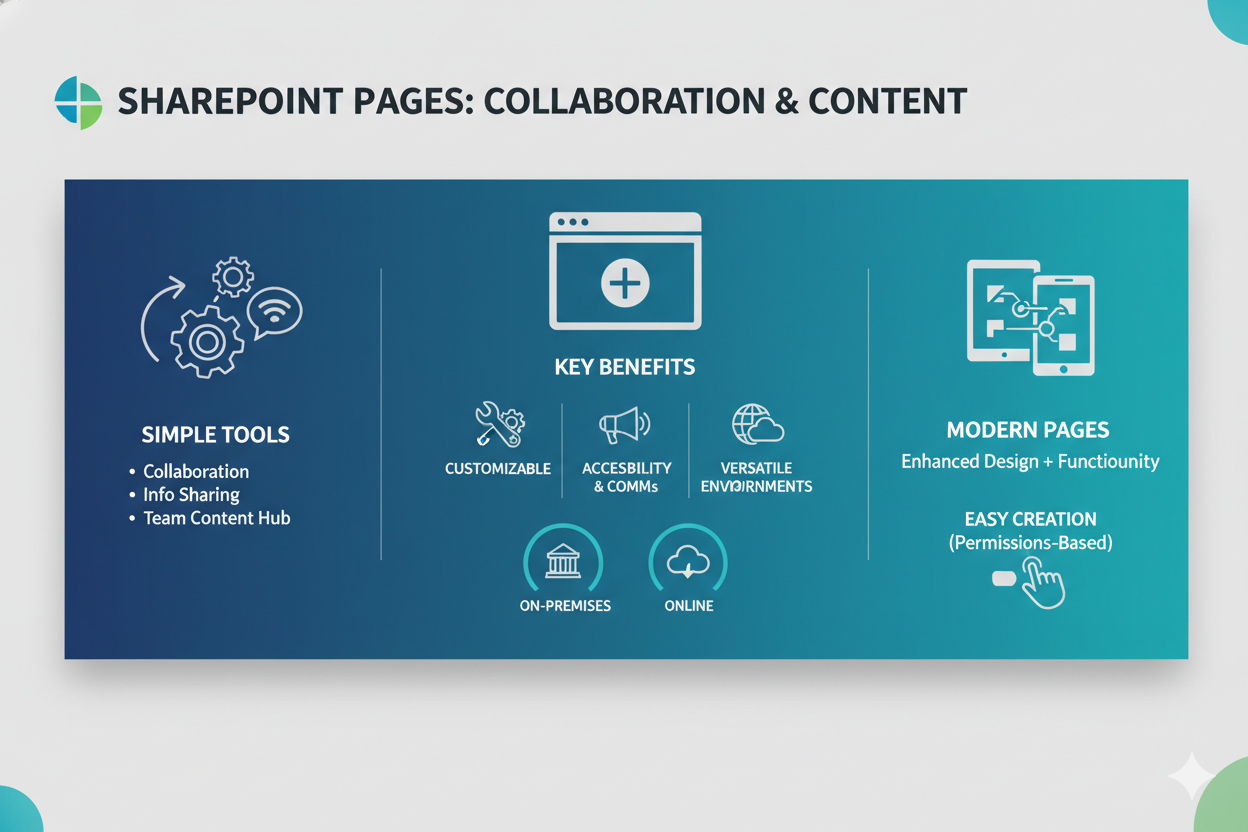SharePoint pages are a powerful tool for collaboration and content management. They allow teams to create, share, and organize content with ease. SharePoint pages provide a central hub for storing important documents, images, and other resources. They help keep everything in one place.
With flexible layouts and customizable features, they help businesses stay organized and efficient. These features can be tailored to fit your business needs. These pages improve collaboration by making it easy to manage and display content. Teams can work together more effectively with centralized content.
Whether you're in a small team or a large organization, SharePoint pages streamline workflows. They also enhance communication across the team. Centric offers insights on how to get the most from SharePoint pages. They show you how to leverage SharePoint to its full potential.
In this guide, we’ll explore the key features of SharePoint pages. We’ll also share best practices for creating effective pages. With this knowledge, you’ll be able to make the most of SharePoint pages. This will help improve your team’s productivity and efficiency.
What are SharePoint Pages?
SharePoint pages are simple tools used for collaboration and sharing information, and they are often the first place users begin when learning what is Microsoft SharePoint. They help teams create and display content while keeping all important information in one place.

They are easy to customize for different needs. SharePoint pages improve communication by making content accessible to all team members,clearly showing what is SharePoint used for in everyday collaboration. SharePoint pages can be used in various environments, including SharePoint on-premise intranet services, as well as SharePoint Online, both offering unique features for building effective pages. These include SharePoint On-premises and SharePoint Online. Both environments offer unique features for creating SharePoint pages. SharePoint modern pages provide better design and more functionality. Creating SharePoint pages is simple and can be done by anyone with the right permissions.
Common 3 Types of SharePoint Pages
SharePoint offers different types of pages for various needs. These pages help organize content in a way that fits the purpose of your site. Whether you're sharing updates with a large group or collaborating on projects, there is a page type for every situation.
Creating SharePoint pages is simple and can be done quickly to match your team's needs. The main types include Communication Sites, Team Sites, and Modern vs Classic Pages.
1. Communication Sites
Communication sites are used to share news and updates with large audiences. They help present important information in a clear and engaging way. These pages are perfect for broadcasting messages across the organization.
2. Team Sites
Team sites are made for smaller groups to collaborate on projects. They allow team members to share documents and manage tasks easily. Team sites are ideal for day-to-day work and collaboration.
3. Modern vs Classic Pages
Modern pages are newer and more flexible. They are easy to use and designed for a better user experience. Classic pages are older and have fewer features. SharePoint modern pages offer improved functionality and design compared to classic pages.
4 Key Features of SharePoint Pages
SharePoint pages offer a wide range of features that make collaboration and content management efficient. These features help teams stay organized, communicate effectively, and share content seamlessly.
Whether you're working with a small group or a large organization, SharePoint pages offer a flexible experience. They are also user-friendly, making them easy to use and demonstrating how does SharePoint work in practical, day-to-day scenarios.
SharePoint pages provide everything you need to manage content effectively, and new capabilities powered by SharePoint AI help automate tasks and enhance user experiences. These features help you organize and streamline your content with ease.
With SharePoint pages, you can easily manage your content in one central place. The SharePoint page user interface is simple to navigate, making it easy to find and edit content. Users can personalize the pages, add relevant web parts, and integrate other tools to enhance their workflow. These features make SharePoint pages the perfect solution for modern workplaces.
1. Page Layout and Web Parts
SharePoint pages offer a flexible layout system. This system allows you to organize content in a way that works best for your team. You can choose from different layouts to suit your needs. The SharePoint page user interface is simple and easy to use.
SharePoint pages allow you to add SharePoint page web parts. These include text, images, and document libraries. You can also embed videos and other media. These web parts make it easy to add and organize content.
2. Personalization and Customization
Users can personalize and customize SharePoint pages to fit their needs, and many businesses use SharePoint customization services to create branded, highly functional layouts.
You can change the layout, themes, and web parts to create a page that works for you. Personalization helps teams stay organized. Managing SharePoint pages becomes easier when you can tailor them to your specific tasks and preferences.
3. Integration with Other Microsoft 365 Tools
SharePoint pages integrate well with other Microsoft 365 tools. You can connect with Power Automate and Microsoft Teams, and users can even learn how to map SharePoint to File Explorer to simplify file access and improve workflow efficiency. When you manage SharePoint pages, it’s easy to connect with tools that improve productivity.
4. Mobile Responsiveness
SharePoint pages are designed to be mobile-friendly. They adjust to different screen sizes for easy viewing on mobile devices. This makes it easier for remote teams to access and edit content on the go. A mobile-friendly SharePoint page user interface ensures your team stays productive from anywhere.
Explore Our SharePoint Consulting Services!
What Are The Benefits of Using SharePoint Pages?
SharePoint pages offer many benefits that improve collaboration and content management. These pages help teams stay organized and work together more efficiently. By using SharePoint pages, businesses can enhance their workflows and communication. Let’s look at some of the key benefits.

1. Centralized Information Hub
SharePoint pages act as a central point for all team collaboration. They store documents, images, and other important resources in one place. Teams can easily find and share information. This makes it easy to stay organized and access the latest content.
2. Improved Collaboration
SharePoint pages improve team collaboration by allowing members to share content and work together. Tools like SharePoint forms make it easier to collect information and streamline processes.
They allow team members to share content and work together on projects. With real-time updates, everyone stays on the same page. Team members can easily comment on and edit documents. This helps streamline workflows and makes collaboration easier.
3. Security and Permissions Management
SharePoint pages have strong security features. You can control who can see or edit content within a site, which is especially important when managing SharePoint site collection with multiple teams and permission levels. SharePoint pages allow you to set granular permissions for different user roles. This ensures that only the right people have access to sensitive content. With clear access control, your team’s data stays safe and secure.
5 Best Practices for Creating SharePoint Pages
Creating effective SharePoint pages requires attention to detail. Following best practices ensures your pages are easy to use and meet your team’s needs. Let’s look at some key tips for creating and managing SharePoint pages.
1. Plan the Structure and Layout
Planning the structure of SharePoint pages is key for user engagement, and organizations often rely on SharePoint Strategy & Planning Services to ensure content is organized logically and effectively. A clear layout makes it easy to find content. Organize your content in a logical way so that users can quickly access what they need. Break up text with headings and sections. This keeps the page clean and easy to navigate.
2. Use Web Parts Effectively
SharePoint pages offer many web parts to enhance content, and SharePoint Development & Customization Services can help teams build tailored components that improve user experience. Use text, images, and documents to make your pages more engaging. When adding SharePoint page web parts, keep the user in mind. For example, use image galleries for visual content and document libraries for easy access to files. Keep it simple and organized for better user experience.
3. Optimize for Search and Navigation
To help users find content easily, optimize SharePoint pages with metadata and keywords. This improves search functionality. Create a clear and simple navigation system. Use links and menus to guide users to important content. Good navigation helps users quickly find what they are looking for.
4. Maintain Consistency Across Pages
Consistency is important when managing SharePoint pages. Keep the design and layout uniform across all pages. This makes the pages easier to use and more professional. Use templates and reusable components to save time and maintain consistency.
5. Regularly Update and Audit Pages
Regularly update your SharePoint pages with fresh and relevant content. Outdated pages can confuse users and reduce productivity. Conduct regular audits to check if content is still relevant. Keep your pages maintained so they remain useful for your team.
Explore Our SharePoint Development & Customization Services!
2 Common Challenges with SharePoint Pages and How to Overcome Them
While SharePoint pages are a powerful tool, there are common challenges that users face. Let’s look at how to overcome these challenges to get the most out of SharePoint pages.
1. Overcoming Performance Issues
Performance issues can slow down SharePoint pages. Slow loading times are a common problem. To fix this, optimize images and other media. Compress large files to reduce load time. Also, use caching to speed up frequently accessed pages. These tips will help SharePoint pages load faster and perform better.
2. Managing Large Volumes of Content
Handling large amounts of data on SharePoint pages can be challenging. Using document libraries and maintaining a consistent SharePoint backup process ensures your files remain secure and recoverable.
To manage this, use document libraries to store files and keep them organized. Implement version control to track changes and avoid confusion. Archiving old content helps keep pages clutter-free. These practices will make managing large content easier and more efficient.
FAQs
What are SharePoint pages Used For?
SharePoint pages are used to organize, share, and manage content within an organization. They enable teams to collaborate by providing a central space for documents, images, and information. SharePoint pages are essential for streamlining workflows and improving communication across teams.
How Do I Create SharePoint Pages?
Creating SharePoint pages is simple. Choose a site, select “Create Page,” and choose a layout. Add SharePoint page web parts such as text, images, or documents. Customize the page to suit your team’s needs. Save and publish to share with others.
Can I Customize SharePoint Pages?
Yes, SharePoint pages are highly customizable. You can change layouts, add or remove web parts, and adjust themes. Personalize the content by adding text, images, and document libraries. Use these features to create a page that fits your team’s workflow and needs.
How Do I Manage Permissions on SharePoint Pages?
SharePoint pages allow for detailed permissions management. You can set who can view or edit the page. Use SharePoint’s security features to assign roles like owner, member, or visitor. This ensures that the right people have access to the right content.
Conclusion
SharePoint pages offer powerful features for collaboration and content management. They help teams stay organized and streamline communication. By following best practices, teams can create effective and engaging pages that improve productivity.
Adopting SharePoint pages enhances collaboration and boosts business efficiency. These pages simplify workflows and ensure everyone is on the same page. Centric specializes in optimizing SharePoint environments through comprehensive SharePoint consulting services that help businesses maximize the platform’s capabilities for improved performance and success.









